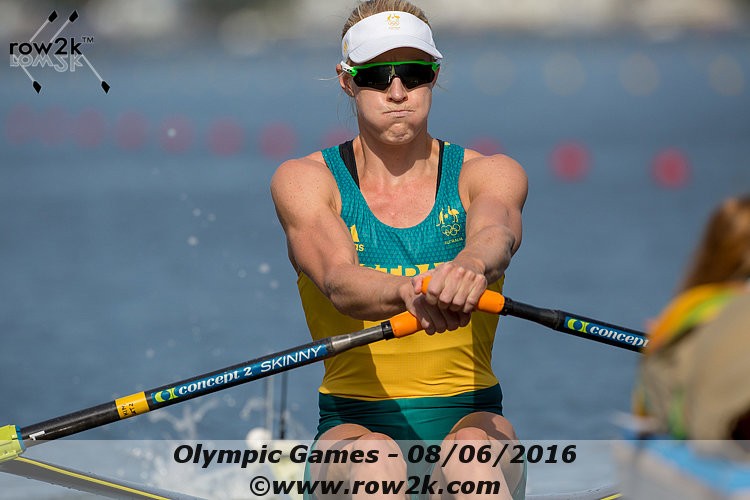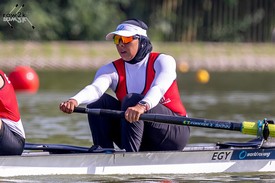Charlotte Hollings, Calm Waters Rowing

In my experience, most scullers are tasked with developing their skills and abilities with little feedback or coaching. With few team boats out at present, that may be changing somewhat, but regardless, here are a few tips on coaching yourself.
Finding the right boat for your skill level is the first step. You want a single that challenges you without terrifying you. If you learn to be afraid, you learn bad habits that become difficult to break.
Once you find the right boat, you will need it to be set up for you. While there are many different rigging criteria, the simplest and most basic are the height and foot stretchers. You want the oarlock at a height that, when on the drive, the oar handle will line up with your low rib/bra strap/heart rate monitor strap (as shown in the photo at the top of this article).
Too high and you'll have trouble keeping the oar buried at the finish, too low and you'll have trouble releasing the oar.
As for the foot stretchers, we set them relative to the finish position. Sit in your layback position and adjust the foot stretchers so that the oar handles almost go past the body. Too much room and your oar handles will go past, which is a precarious position to find yourself in and may well lead to a dunking. Too little room and it becomes more difficult to release the oar.

The pitch of the oarlock is very important as well, but for this you need a pitch meter and more knowledge of rigging. Most new boats will come rigged with 4 to 6 degrees pitch, and hopefully most club boats are within that range as well. If you consistently find one oar behaving erratically, digging deep or having trouble staying in, find someone with a pitch meter to help you determine whether the problem is the boat or you; you will want to make sure both oarlocks have the same amount of pitch.
Balance comes next. When you get in the boat, hold onto both oars with one hand while the blades rest on the water, hold tight, and then shake your body. Feel how stable the boat is? That's because the oars are at the right height and are not wobbling while your body moves around. This is what you need to do to maintain the balance while rowing - keep the oar handles steady and level.
There is very little difference between the height of the drive and the height of the recovery so don't overdo the lift at the catch or the tap down at the release. Initially, let the blades skim across the surface of the water on the recovery, and then think about coming right straight back towards the body on the drive.
Know that the blade will float at the correct depth. To see for yourself, hold the boat steady, square one oar and then take the weight of your hand off that oar handle and let the blade float. That's the depth you want the blade to be during the drive and as long as the boat is level, that's the height you want the oar handle to be on the drive.

Most people have trouble staying level; they go up during the middle of the drive and then end up too low at the finish. Look out at the shaft of the oar to see how deep the oar gets during the drive. (Not while you're rowing, that tends to offset the boat.) If the waterline is over one third of the way up the shaft, the blade is going deep.
Many rowers swear they're pulling horizontally when in actuality they're pulling 'over the barrel.' When this happens, I tell people to feel like they're pulling down in the middle of the drive and then up a little at the finish. If up and down feels level, then it reasons that level will feel down and up.
Another trick is to sit at the catch, full slide with the blades squared and buried. Without moving the knees, gently bring the hands back to the knees. This is the height you want the hands to be in the middle of the drive. Use your knees as a guide. Yes, the knees will go down when you're actually rowing, but you want the hands to come through where the knees were.
The main cause of going deep during the drive is lifting the body at the catch. You want the head to remain steady throughout the stroke, to stay on the same level on the drive as on the recovery. Wear a hat and see where the brim of the hat is relative to the horizon. If that view changes at any point during the stroke, i.e., you start to see a whole lot more of the horizon, you'll know your head is going up.
Figuring out the proper hand heights during both the drive and the recovery will go a long way to making you feel more comfortable in your boat. Focus on that first and in our next article, we'll talk more about the drive and the release as you work to become your own best coach.
If you enjoy and rely on row2k, we need your help to be able to keep doing all this. Though row2k sometimes looks like a big, outside-funded operation, it mainly runs on enthusiasm and grit. Help us keep it coming, thank you! Learn more.
Comments | Log in to comment |
- Bont Rowing
- Calm Waters Rowing
- Concept 2
- Craftsbury Sculling
- The Crew Classic
- CrewLAB
- Croker
- Durham Boat Co.
- Empacher
- Faster Masters
- Filippi
- Fluidesign
- h2row.net
- HUDSON
- Live2Row Studios
- Nielsen-Kellerman
- Oak Ridge RA
- Peinert Boat Works
- Pocock Racing Shells
- Race1 USA
- RowKraft
- Rubini Jewelers
- Vespoli USA
- WinTech Racing
- Bont Rowing
- Calm Waters Rowing
- Concept 2
- Craftsbury Sculling
- The Crew Classic
- CrewLAB
- Croker
- Durham Boat Co.
- Empacher
- Faster Masters
- Filippi
- Fluidesign
- h2row.net
- HUDSON
- Live2Row Studios
- Nielsen-Kellerman
- Oak Ridge RA
- Peinert Boat Works
- Pocock Racing Shells
- Race1 USA
- RowKraft
- Rubini Jewelers
- Vespoli USA
- WinTech Racing


















11/18/2020 2:05:57 PM
11/17/2020 6:01:08 PM